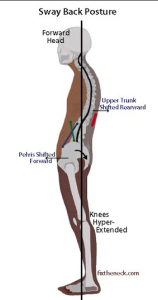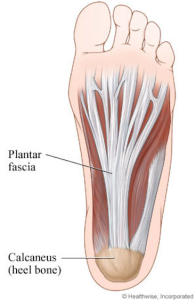by admin | Feb 8, 2016 | Uncategorized
Hyperextension is the movement of a joint past its normal range. All our joints have an optimal range of movement, which they are designed to function optimally within. They are also designed to be able to a little bit beyond that range as a mechanism to protect from injury.
If the knee joint is hyperextended the shin bones are pulled backwards in relation to the foot.

The bones of the body are meant to stack one of top of the other in order to transfer ‘forces’ through the joints and the body. If the knee joint is hyperextended, it puts greater strain on the ligaments at the back of the knee and has the impact of unbalancing the muscles above and below the joint. Ultimately the whole body is affected as our lower body doesn’t work in isolation of the upper body.
If our daily habits assist in the hyperextension of the knee, the joint will gradually become lax. This laxity can then transpose into our movement when standing and walking. So, when walking our leg straightens as our heel strikes the ground and transfer forces up the leg the bones of the leg should stay in parallel. If there is laxity at the joint at this point the knee effectively moves backwards, closes the space of the knee joint and increases the likelihood of wear and tear of the joint.
Signs you might be a ‘knee extender’?
- Loss of definition of the vertical creases at the back of your knees.
- Your legs look like they’re bending backwards.
If you recognise that you’re a ‘knee extender’ what can you do to break the habit?
- Keep checking your knee position when standing. They should be soft and feel relaxed but not bent.
- Take shorter steps when walking. This will also help you move from your core as opposed to your extremities.
by admin | Dec 1, 2015 | Uncategorized |
 For the past couple of months I’ve been learning more about nutrition. Not just the eat 5 fruit and veg a day (you do, don’t you?) but getting at the nuts (get it?) and bolts. The macro-nutrients and the implications for our bodies.
For the past couple of months I’ve been learning more about nutrition. Not just the eat 5 fruit and veg a day (you do, don’t you?) but getting at the nuts (get it?) and bolts. The macro-nutrients and the implications for our bodies.
Many factors make up our nutritional needs picture. Our individual biological requirements can vary fourfold between different people, the stressors that we are exposed to i.e. smoking exposure or types of medications taken and the overall health of an individual. When there is a discrepancy between the needs of the body an our input, the body is unable to repair itself sufficiently and inflammation occurs, which can lead to degeneration of any system within the body.
But if you have a healthy diet that shouldn’t matter? Well not necessarily. Did you know that a cauliflower has ½ the vitamin C content and watercress 88% less iron that they contained 50 years ago. Bananas need to ripen on the trees to fully develop their nutritional content but they are picked to be shipped when green. Supermarkets are allowed to cold store apples for 6 months before going on sale. The nutritional value of an apple halves for every month it is stored. So, it turns out that eating a ‘healthy’ diet may still not be as nutritious as we need it to be.
Are you bamboozled? I was at this point. But don’t worry. There are many things that can be done to. Add a more veggies to your plate. Steam rather than boil, to keep as many of the nutrients as possible. Reduce the amount of wheat/gluten, dairy, caffeine, alcohol and sugar in the diet.
Let me know if you want to discuss any of this information further.
by admin | Nov 17, 2015 | Uncategorized
 Last time we looked at the importance of an aligned spine and good posture. So, what are the other types of common deviations from this optimal position?
Last time we looked at the importance of an aligned spine and good posture. So, what are the other types of common deviations from this optimal position?
Do I remind you to push your hips back in class? If so, you may have developed a Swayback posture. In a swayback posture the hips fall forward of the mid line. So, instead of the plumb line falling from the hip to the ankle it would fall over the toes or further forward! The shape of the spine does not appear to change but it puts the body into a constant backwards bend.
In terms of how it influences the body, it causes the muscles at the front of the body to lengthen and weaken. It’s a bit of a ‘lazy’ posture and also means that the muscles at the back of the body don’t lengthen but they also become weakened especially the buttocks.
So, in a swayback posture the muscles are weakened at the front and back of the pelvis. This is the most important area for support of and movement of the body. So, what could the long term effects of this posture on the body be? Premature wear and tear of the hip sockets and lower spine due to compression of the joints because they are not being supported by the muscles. The upper neck may also experience wear and tear issues as the body will try to bring the head forward to balance out the backwards bend. Also, issues in eth feet e.g. plantar fasciitis, bunions, arthritis, may develop because the small joints of the feet are taking the weight of the body rather than the heel which is designed to take the impact of movement.
Resolving to this posture type can help to alleviate the issues above and it’s the easiest to do! All you have to do is commit to standing tall.
by admin | Jul 28, 2015 | Uncategorized
 Can you believe we are over half way through the year already? It’s been all about our feet this week. How much thought do you give to the health of your feet? They are your contact with the world. They are complex machinery. You have just over 200 bones in your body and 25% of them are in your feet. A quarter of your muscles and motor nerves are also found there. They are like the wheels on your car. We look after them because we know what happens to the condition of the tyres when the tracking is out. Do you look after feet in the same way?
Can you believe we are over half way through the year already? It’s been all about our feet this week. How much thought do you give to the health of your feet? They are your contact with the world. They are complex machinery. You have just over 200 bones in your body and 25% of them are in your feet. A quarter of your muscles and motor nerves are also found there. They are like the wheels on your car. We look after them because we know what happens to the condition of the tyres when the tracking is out. Do you look after feet in the same way?
I thought I’d put some information together about a foot topic that kept coming up when we got chatting in class. A condition called Plantar Fasciitis. So many had either been personally or knew someone who had been afflicted. As many as 1 in 10 people are reported to experience the condition at some point. So, what is it?
Plantar Fasciitis
Plantar Fasciitis is an overuse syndrome characterized by inflammation or degeneration of the fibrous tissue (the plantar fascia) that connects the heel and the toes. Its job is to support the bones in the feet in weight-bearing and assist with the transfer of load through the foot during motion. It works like elastic. When you roll through your foot during walking it stretches to lengthen the foot to allow force absorption.
The first sign of the development of the condition could be pain or stiffness in the arch of the foot or at the heel after prolonged walking or after a long period of rest. This may be especially noticeable first thing in the morning.
There are many potential reasons why Plantar Fasciitis may develop but essentially they boil down to postural and biomechanical deviations from optimal alignment. One of the biggest influences on the health of the feet is the position of the pelvis. One common postural adaptation we adopt is to place our pelvis in front of our body.

A forward pelvis position places the load of the body through the small bones and tissues of the front of the foot. This over works the plantar fascia, increasing the risk to damage to the soft (ligaments/tendons) and hard (bone) tissue. In Pilates we constantly work to optimize the position of the Pelvis to maximize the health of the joints and tissues in the rest of the body.


 For the past couple of months I’ve been learning more about nutrition. Not just the eat 5 fruit and veg a day (you do, don’t you?) but getting at the nuts (get it?) and bolts. The macro-nutrients and the implications for our bodies.
For the past couple of months I’ve been learning more about nutrition. Not just the eat 5 fruit and veg a day (you do, don’t you?) but getting at the nuts (get it?) and bolts. The macro-nutrients and the implications for our bodies. Last time we looked at the importance of an aligned spine and good posture. So, what are the other types of common deviations from this optimal position?
Last time we looked at the importance of an aligned spine and good posture. So, what are the other types of common deviations from this optimal position? Can you believe we are over half way through the year already? It’s been all about our feet this week. How much thought do you give to the health of your feet? They are your contact with the world. They are complex machinery. You have just over 200 bones in your body and 25% of them are in your feet. A quarter of your muscles and motor nerves are also found there. They are like the wheels on your car. We look after them because we know what happens to the condition of the tyres when the tracking is out. Do you look after feet in the same way?
Can you believe we are over half way through the year already? It’s been all about our feet this week. How much thought do you give to the health of your feet? They are your contact with the world. They are complex machinery. You have just over 200 bones in your body and 25% of them are in your feet. A quarter of your muscles and motor nerves are also found there. They are like the wheels on your car. We look after them because we know what happens to the condition of the tyres when the tracking is out. Do you look after feet in the same way?
Recent Comments